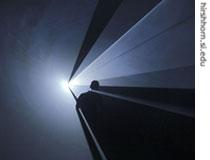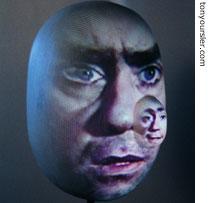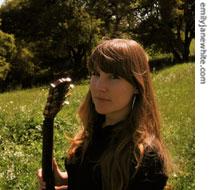VOA慢速英语 2008 0404b
搜索关注在线英语听力室公众号:tingroom,领取免费英语资料大礼包。
(单词翻译)
HOST:Welcome to AMERICAN MOSAIC1 in VOA Special English.
(MUSIC)
I’m Doug Johnson. On our show this week:
We play music by singer/songwriter Emily Jane White …
Answer a listener’s question about the place where America holds its gold …
And report about a dreamy exhibit at the Hirshhorn Museum in Washington...
(MUSIC)
Hirshhorn Art Exhibit
HOST:
 |
| From Anthony McCall's ''Your and I Horizontal'' |
This spring in Washington D.C., you can visit a video art exhibit called “The Cinema Effect: Illusion, Reality and the Moving Image.” The exhibit can be seen at the Hirshhorn Museum, the modern art center of the Smithsonian Institution.
The first part of the show is called "Dreams." It explores the way in which movies have changed the way people experience reality. As we hear from Faith Lapidus, it also looks at how movies can take us away from our normal lives to a world of dreams and imagination.
FAITH LAPIDUS:
Some videos in the exhibit show peaceful worlds that are beautiful in an unusual way. In “Overture” by Stan Douglas, you seem to travel through a mountain environment like an engineer sitting in the front of a train. The train and the quality of the recording2 suggest the film is very old. Douglas included a recording of a man talking about his thoughts and dreams. You cannot tell if the calm voice is talking about reality or if the man is asleep.
In another video, the video projector3 itself is part of the art. A large, old projection4 device from the nineteen sixties shows the video on a wall. Canadian artist Rodney Graham made the film in black and white. It shows a white material falling like snow on an old Rheinmetall typewriter. The snow slowly covers the machine until it becomes unrecognizable.
Not much happens at all in another video, Andy Warhol’s famous movie “Sleep." It shows a man as he sleeps. The recording lasts for several hours.
Other videos in the exhibit are frightening. The German artist Christophe Girardet used a few seconds of the actress Fay Wray in the nineteen thirty-three movie “King Kong.” In one part of the movie, the actress shouts when she sees the huge creature. The artist worked with the video so that the images are repeated again and again. Fay Wray seems to be doing a strange dance as she shouts.
 |
| An example of a work by Tony Oursler |
The American artist Tony Oursler has three works in the exhibit. He places videos of human faces on round objects to make unusual talking creatures. In one work, a video of a person’s eye can be seen on a ball. If you look carefully, you can see a moving image like a television in the eye. As the eye sees brighter and darker images, the pupil of the eye increases and decreases in size.
In June, the Hirshhorn Museum will show the second part of this video exhibit. It will be called “Realisms.”
Fort Knox
Host:
Our question this week comes from Nigeria. A listener named Funsho asks about Fort Knox.
Fort Knox is the name of an Army base in the southern state of Kentucky. But the name is better known for its link to gold.
 |
| The United States Bullion5 Depository at Fort Knox |
Since nineteen thirty-seven, the United States Bullion Depository at Fort Knox has housed a large portion of the government’s gold reserves. The depository is next to, but not part of, the Army base. The building is under the control of the United States Mint, which is part of the Treasury6 Department.
The Fort Knox Bullion Depository holds over one hundred forty-seven million troy ounces of gold. A troy ounce is a measurement used for jewels and metals like gold and silver.
The amount at Fort Knox is equal to more than four and one-half million kilograms of gold. The gold is in the form of coins and bars. The bars measure about seventeen centimeters long and nine centimeters wide.
In nineteen thirty-three, President Franklin Roosevelt ordered an end to the use of gold as money. The newly elected president did this as part of his New Deal economic plan during the Great Depression. Private ownership of gold that was not in the form of jewelry7 or collectable coins became illegal.
So people who owned gold exchanged it with the government for paper money. Soon, the government needed a safe place to store its growing amounts of gold. The Treasury Department started building the Fort Knox depository in nineteen thirty-six.
As you can imagine, the building has very high security. In fact, the term “Fort Knox” is used in popular language to describe something that is carefully protected.
The gold is housed in a two-level vault8 made of concrete and steel. The Treasury Department Web site says no one person knows the code that opens the vault. Instead, several people must each enter a separate code to unlock it.
Other valuable objects have been stored at Fort Knox over the years. These include the Declaration of Independence, the Magna Carta and three versions of the Gutenberg Bible. The Gutenberg Bible was the first major book printed in Europe with movable type.
Don’t get too excited about visiting Fort Knox. The bullion depository is not open to the public.
Emily Jane White
HOST:
 |
| Emily Jane White |
Emily Jane White performs richly descriptive songs that often tell dark and mysterious stories. The twenty-six year old singer says her music attempts to reach out for an understanding of other people’s experiences. One critic says the music is filled with a warm physicality.
Her first collection of songs, “Dark Undercoat,” combines the sounds of blues9 and folk music. Barbara Klein has more about White in this report.
(MUSIC: "Bessie Smith")
BARBARA KLEIN:
That was Emily Jane White with “Bessie Smith.” The song honors one of the great blues singers of the twentieth century.
White grew up playing the piano and listening to her father play the guitar. But it was not until she started attending the University of California-Santa Cruz that she decided10 to teach herself to play the guitar. She also began writing music. In her classes, she learned more about the political roots of folk music. She says most of her songs are not political. Yet they express an interest in and reaction to the lives of other people.
After college, Emily Jane White moved to France for a year and performed with a group called the Diamond Star Halos. Crowds of listeners were very supportive and asked her when she would make a record.
White moved to San Francisco in two thousand six. After five years of songwriting, she had many choices for her album. The poetic11 songs describe a dreamy world of night skies, strong desire, and even death.
Here is her song “Hole in the Middle.” White says she wrote it to answer the American government’s decision to invade Iraq.
(MUSIC)
Emily Jane White is back in France again this month. Crowds there might hear her play this song, “Time on Your Side.” It was influenced by her love of American country music.
(MUSIC)
HOST:
I'm Doug Johnson. I hope you enjoyed our program today.
It was written and produced by Dana Demange. For transcripts12, MP3s and podcasts of our programs, go to voaspecialenglish.com.
Join us again next week for AMERICAN MOSAIC, VOA’s radio magazine in Special English.
 收听单词发音
收听单词发音 




